according to your reading about search and google, what are the two biggest trends in search
At large briefing halls and small conference rooms, yous hear these things a lot:
"Google changes everyday…"
"The Google algorithm is updated 500 times per yr…"
"You need to stay on summit of your rankings…"
Merely what if the biggest changes in Google accept nothing to do with rankings?
Yes, Google is constantly changing. And aye the changes bear on your traffic. But no, the biggest SEO trends don't impact your rankings. They affect your click through rates. At that place's a large difference.
Travel back in time with me…
Years ago, the typical SERP (search engine results page) looked much different. In 2014, if you lot searched for skin intendance products, yous'd have seen something like this:
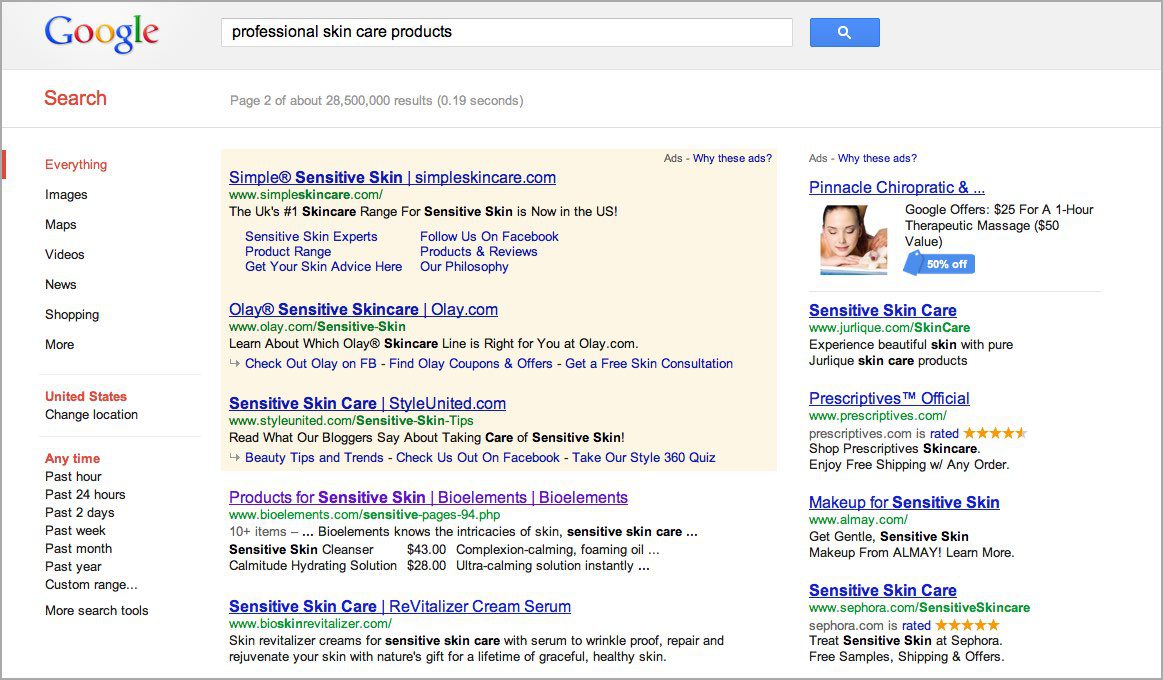
Ah, those were the days. The colors, the columns, the obvious ads. Even then, images and stars were starting to appear, but this was but the beginning.
Calendar month later on month, year after year, Google search results have kept changing. Information technology is a wearisome only continuous evolution toward a more visual, more engaging experience.
Three years agone, I started collecting screenshots of Google search results pages. I already had an archive of onetime screenshots of SERPs used to create presentations and manufactures. But by taking regular, full-folio screenshots of specific phrases every few months, the big flick became very obvious.
Here is a uncomplicated, visual analysis of this SEO trend. We'll share the all-time examples from hundreds of SERPs going back 10 years. And at the cease, we'll share tips for adapting your marketing to these changes.
Search results are getting more visual
More searches than e'er are showing images, videos, "People also ask" boxes, maps and featured snippets. Here we track the search results for the phrase "How to write a headline" over three years…
Editors note: Apologies to those on mobile devices. To view these properly, switch the slide viewer to total screen fashion or you tin view it here. Sorry about that!
Over just a year and a half, the SERP transforms from "x blue links" to a richer, more than interactive page with 3 SERP features filling the viewport above the fold: images, a featured snippet and the "People also ask" box.
This both reduces the need that visitors need to click on anything, and increases the likelihood that if they do click, they'll click on another Alphabet/Google product (images, ads, maps, YouTube).
Permit'due south expect at the functioning of a specific page. Our research piece about web design standards has ranked well for many years. Nosotros utilise Moz to track the rankings. Nosotros use Search Console to track the clickthrough rates (CTR). We use Analytics to track the traffic.
When we map these three together, yous can see the rank is basically steady, but as CTRs fall, traffic drops. Accept a look:
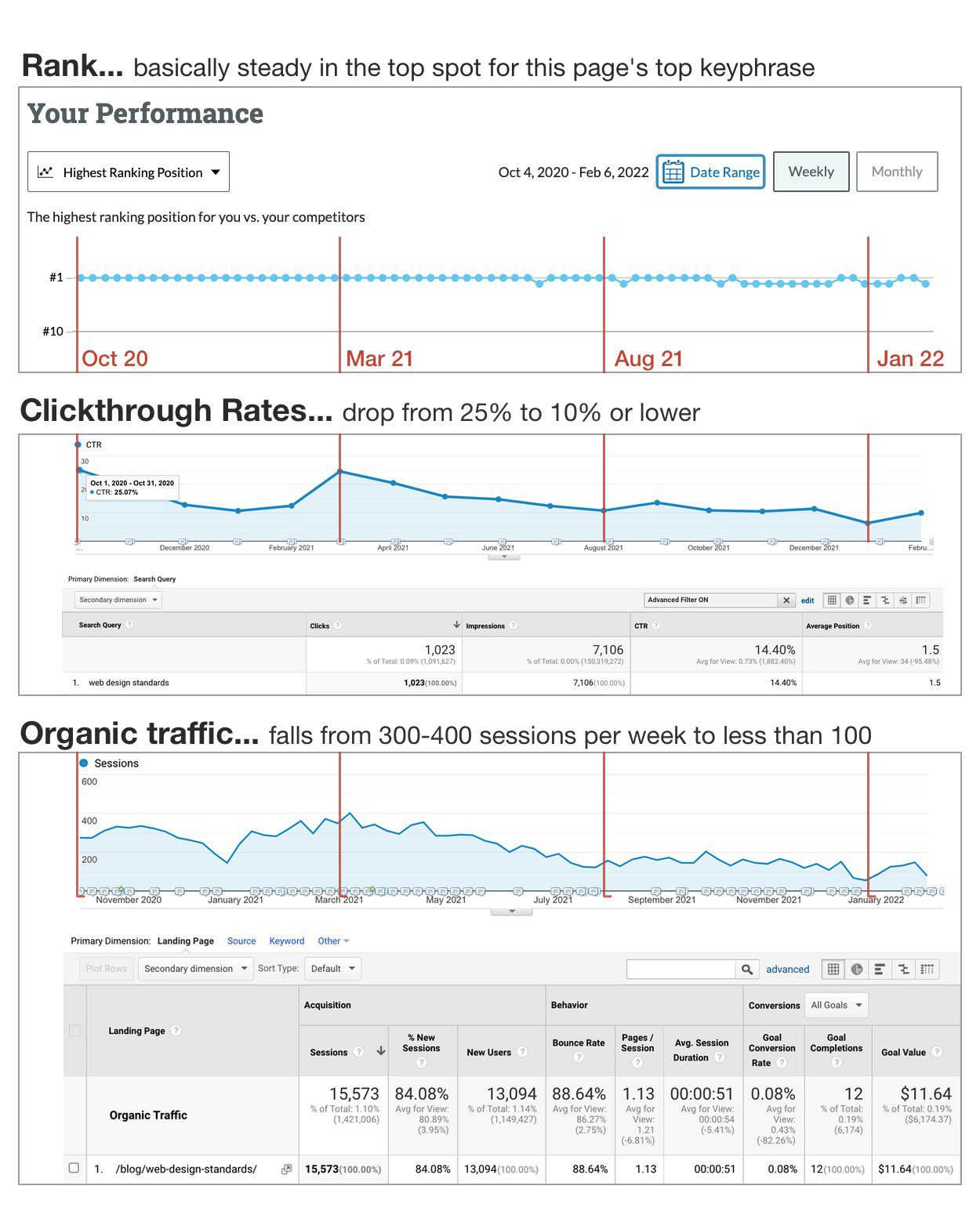
Rankings are durable. Placement is not.
Are you lot surprised at how little the rankings change over the years? I am not. That page has ranked at or near the top of search results for seven years.
In our feel, pages that rank well tend to continue to rank well over long periods of time. Many rankings are very durable, often holding a position for five years or longer.
What affects the charge per unit at which rankings change?
The immovability of a search ranking depends on the rate at which new pages are published on that topic.
In other words, ranking fluctuations are more a role of the topic than the algorithm. In that location are many sleepy corners of the net where a URL can concur a top spot for 10+ years, simply because at that place isn't a lot of new content beingness published on that topic.
Ranking algorithm updates are real, but they aren't the big change to search and SEO. The biggest change is visible to everyone, apparently every bit solar day. It's the "SERP features" (featured snippets, maps, images, videos, etc.). There'south just a lot more than stuff showing up in search results these days.
Hither is a list of SERP features. This chart shows when they offset appeared and the likelihood that they appeared iii years ago compared to today, in March 2022, according to MozCast.
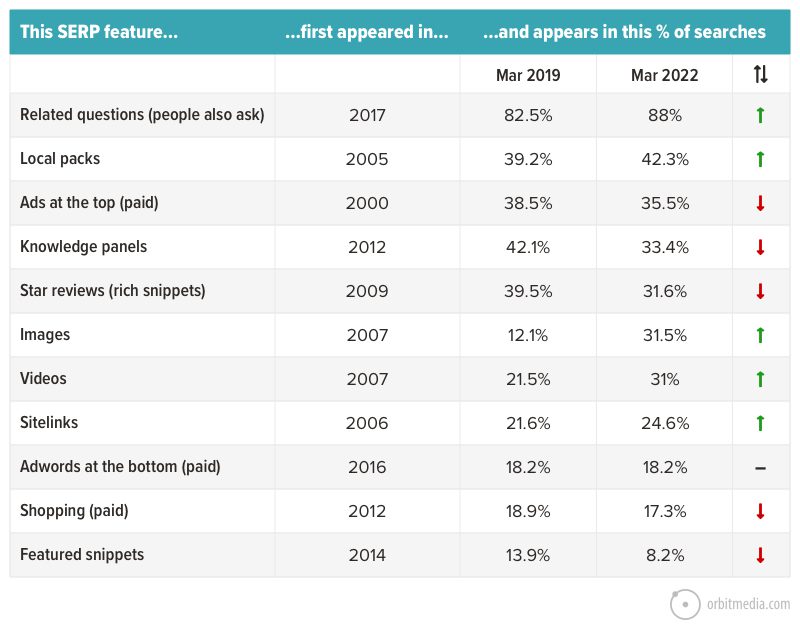
Times change fast! Welcome to the fast-evolving UX of the SERPs. Here's what'south happening:
- Visuals (images and videos) are actualization far more oftentimes than before
- Related questions are almost ubiquitous
- Featured snippets and knowledge panels, one time huge topics in the SEO community, are on the decline
More features in more search results pages reduce the visual prominence of organic rankings, thereby reducing CTRs and traffic to websites. Hither is a side-past-side comparison of 2 search results pages for the phrase "modern nuptials dresses."
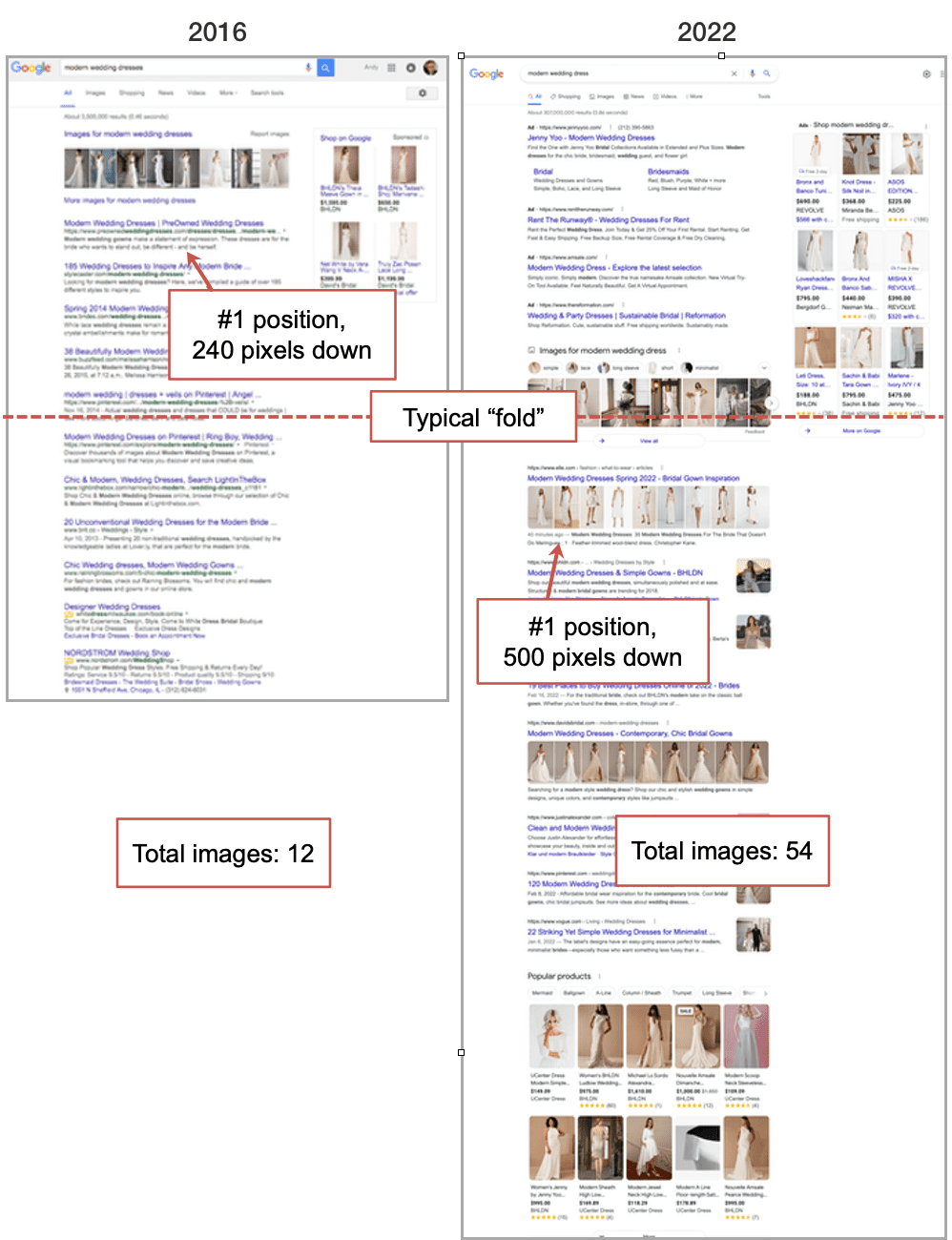
In 2016, the search results helped visitors detect websites with wedding dresses. In 2022, the search results look more similar a conjugal mag. Yous can see dozens of dresses without visiting another website.
Simply this is a high-volume, low-intent phrase for the B2C consumer doing early-stage research. Kathryn of Copy House explains why this isn't a problem for everyone.
 | Kathryn Strachan, Director and Owner Re-create House"Google's consistent development of the SERPs isn't designed to help yous as a content creator, merely to keep users on Google's search. The longer you stay on Google's SERP, the more they take to gain. Nevertheless, I feel that this more often than not impacts the B2C infinite. In B2B, the answers to users' search terms are more than circuitous, requiring longer and more in-depth answers. As long as your brand creates useful and meaningful content, and if you accept consequent SEO, your content volition become seen. Users will continue to scroll down the first page of Google and will click on your brand'due south content because they know you can give them the answers that Google can't." |
Videos are bigger and appear more often
Videos have appeared in search results, every bit rich snippets, since 2012. They were basically a search list (aka "search snippet") like any other, simply with a video thumbnail.
But in 2018, things changed. That'due south when the video carousel beginning appeared. At first, it was just 3 video thumbnails.
Since then, it's been redesigned several times, always getting bigger and more interactive. And of course, flipping from horizontal to vertical ways more videos can be added within the viewport.
Have a look:
Editors notation: Apologies to those on mobile devices. To view these properly, switch the slide viewer to full screen mode or yous can view it here. Distressing nigh that!
More than engagement on the carousel means less engagement on organic listings and other SERP features. The odds that the visitor stays within the search results.
Search results offering more things to click
All of those SERP features give the visitor more opportunities to engage with the page. Search results pages become longer and more interactive.
Compare these two examples for the phrase "infirmary to home"
- In March 2019… you got x blue links, plus some sitelinks under the elevation list.
- In March 2022… You go a lot more: an ad with site links, a featured snippet with an paradigm, iv related questions and images.
Do the same search exactly iii years later on. You become a search results page that is 35% longer and has 131% more things to click. Today, many SERPs have l+ clickable links and buttons, even if you don't count the menu and related searches links.
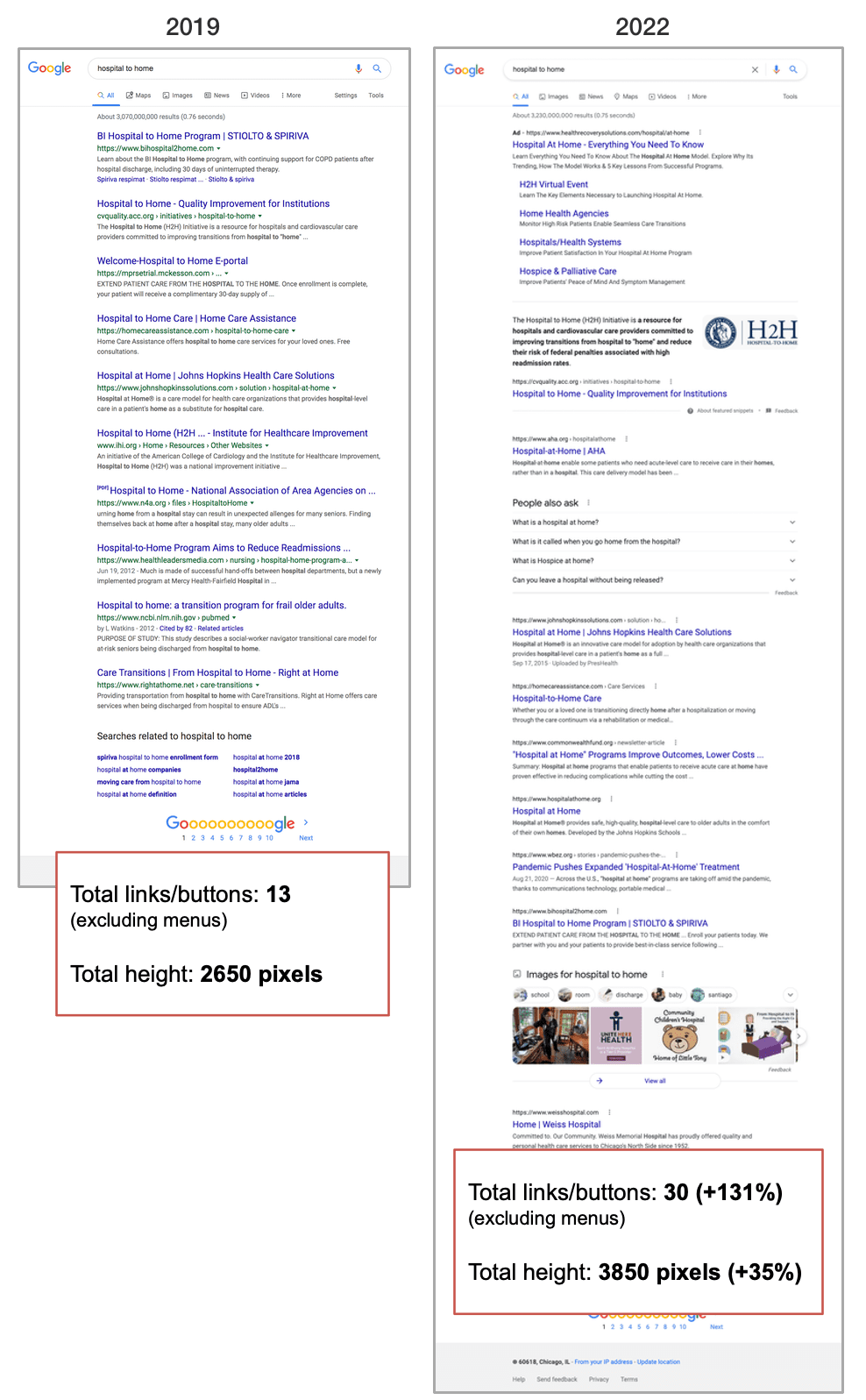
Changes in PPC ads
Google is a wonderful way to find useful websites. Merely those clicks on those organic rankings don't pay the bills. They merely generate acquirement when we click on ads, where they get paid per click. And in 2021 those clicks generated $209B in revenue, upwardly 42% from 2020.
That increase could be explained by more searches or higher prices, but information technology besides seems likely that Google has plant ways to increment the clickthrough rates for ads.
If I were a designer at Google, hoping to increment CTR on PPC ads, I'd brand them bigger. Or I'd add more opportunities to click. Or I'd endeavour to blend them in more with organic listings.
Google has done all of those things.
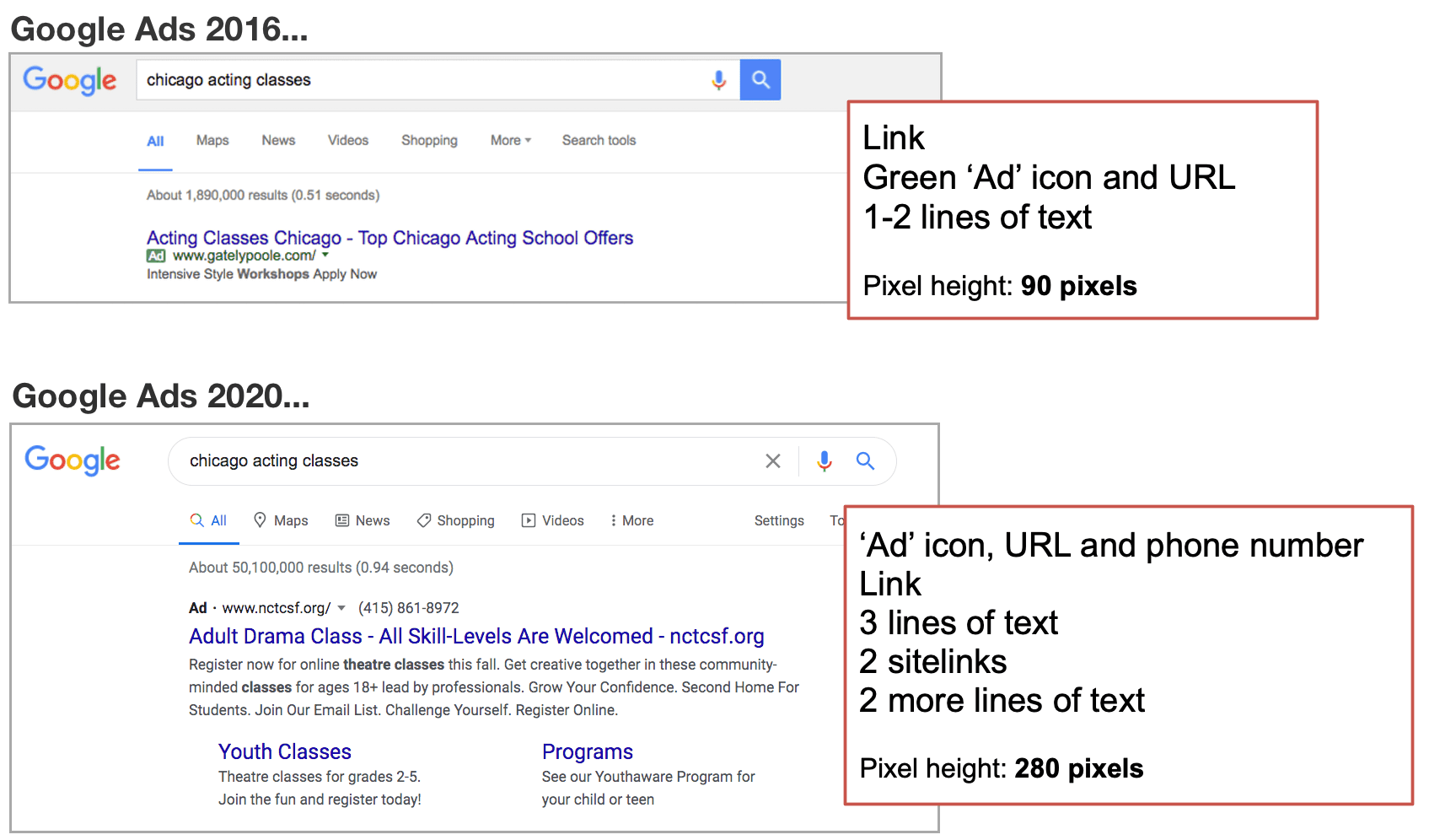
Assuming the landing pages are helpful, loftier clickthrough rates on ads are skilful for searchers, practiced for advertisers and expert for Google. This isn't a conspiracy. It'south ethical commerce with common benefits for everyone involved.
The organic rankings beneath these ads aren't really involved.
Before we jump into the practical tips, allow'due south get the perspective of search marketing veteran Volition Critchlow.
 | Will Chritchlow, CEO of SearchPilot"I do retrieve Google could detect itself in tricky places with the scale and depth of data that they are substantially scraping and displaying on their own pages. However, every bit a marketer, despite the changes to search result pages and associated drops in clickthrough rate / zero-click searches, I remain bullish on organic search. I believe information technology volition remain the biggest channel – certainly for new customer conquering – and has the chapters to grow for well-nigh businesses. My feel is that the growth in demand and web usage has outstripped Google's cordoning off of areas of the search results for themselves exterior of some specific verticals. I'd still honey to see some real serious contest for them though as I believe that (rather than regulation) would be the near powerful commuter of alter." |
Then what's a digital marketer to do? v means to suit.
Get-go, there'southward no utilise lament virtually it. That'due south similar a farmer lament about the weather. Information technology's pointless. If you can't control something, piece of work effectually it. Work with it. Adapt.
Yeah, Google has gotten ameliorate at keeping people on its website through some basic UX changes to search results.
- More visuals (images and videos)
- More types of media/formatting (stories, questions, carousels, widgets)
- More than opportunities to click (50+ links and buttons on many SERPs)
- Longer pages
They have done years of enquiry and spent millions on testing to create a loftier-date experience for visitors and this is how they've changed.
Here are 5 means that the digital marketer tin adapt to this always-evolving reality.
1. Make your ain website more engaging
The get-go lesson is that these types of changes work. They are constructive at improving visitor engagement. And we tin can apply them on our own website
Look at your pages and inquire yourself if you can't brand your own, Google-style improvements.
- Add together more than visuals (images and videos)
- Add more types of formatting (subheads, lists, quotes/testimonials, bullets)
- Add more than opportunities to click (internal links, jump links, calls to action)
- Longer pages (particular, depth, examples, stories)
ii. Work hard on your headlines (write loftier CTR championship tags)
If you rank and the visitor sees your search listing, they'll practice a split-second toll-benefit analysis. Is this click worth 2-seconds of my time?
If yep, you earned a visitor. This is how great headlines work.
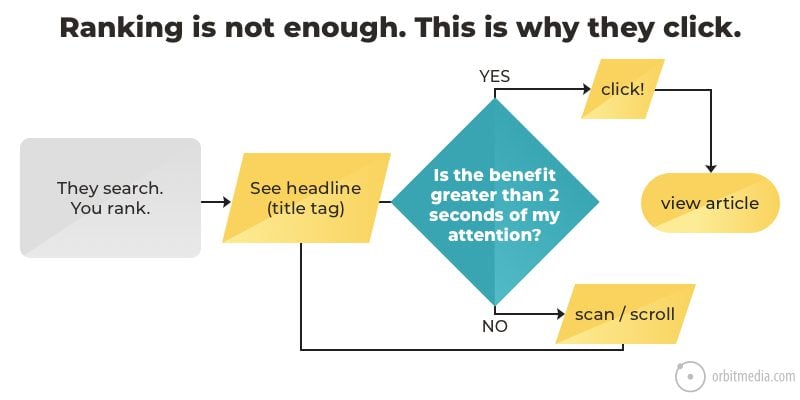
To increase the clickthrough rate to your page, write a title tag with a headline that works with the psychology of the potential visitor. There are three ways the headline does this:
The benefits look high…
The reason to click is obvious and specific. Make a strong hope, only don't oversell it. "Complete guide to increasing clickthrough rates and maximizing traffic to whatever mail"
The cost seems low…
The content sounds scannable and is fast or easy to swallow. Indicate it'south a list or has visuals."v Quick ways to increase your clickthrough charge per unit (plus 12 examples)"
It'southward unexpected…
Employ a weird discussion in your title tags. Make it stand out. Make it interesting or interesting. "Lessons from a reformed spammer virtually increasing clickthrough rates"
Social media and email pros are experts at triggering the psychology that triggers clicks. Merely SEOs often just cram in keywords without thinking much nigh human psychology. See what'south working in a social and email, and so go update your titles for your loftier ranking, low CTR pages.
3. Publish videos
If y'all know what format is winning for a target keyphrase, publish content in that format.
If you run into videos in the search results for the phrase you're because, publish videos.
If you can't beat them, bring together them. At that place really is no other option.
- The SEO pessimist complains that the video carousel reduces CTR to pages.
- The SEO optimist sees an opportunity to win two spots in the search results.
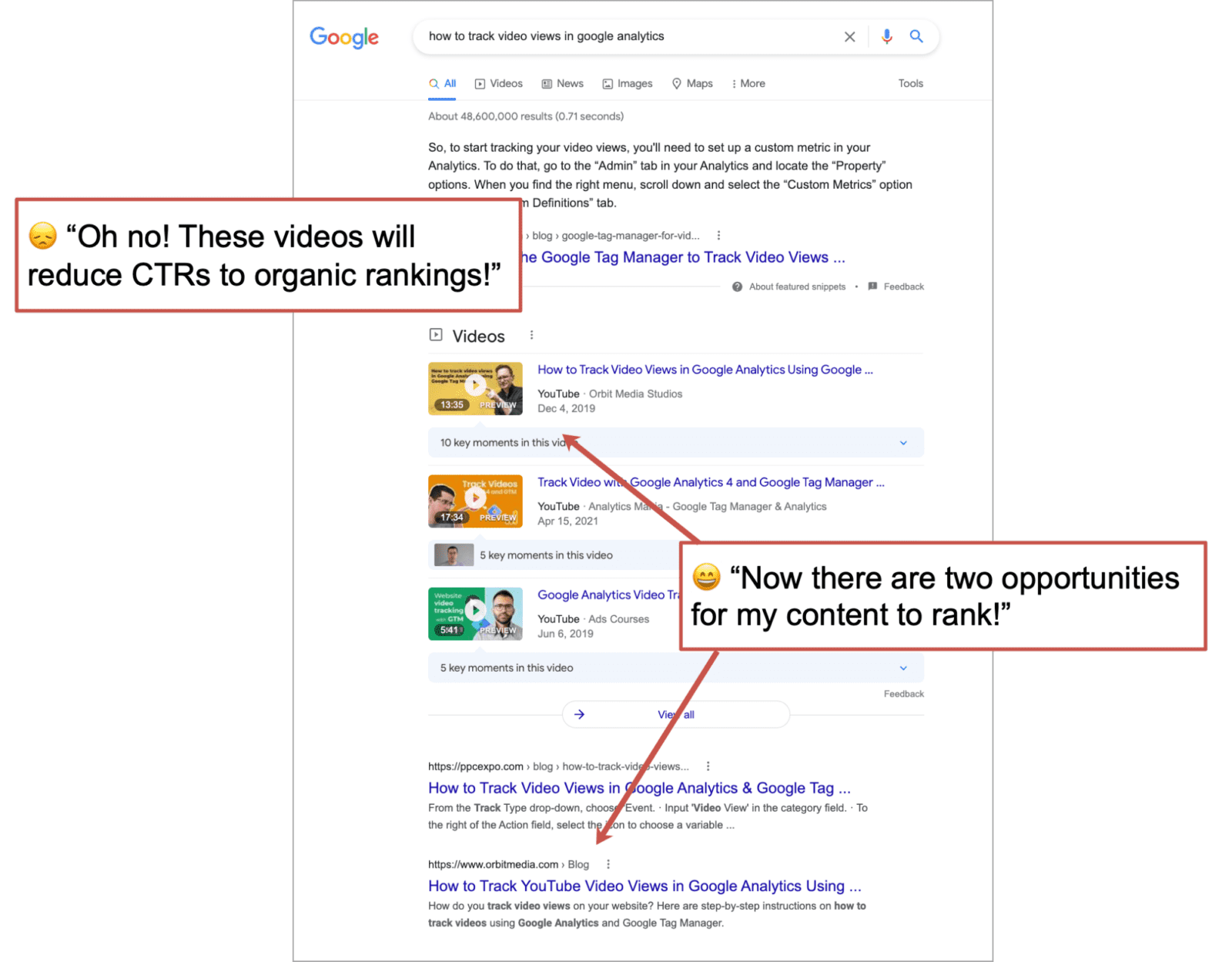
Because the videos within video carousels are almost e'er videos from YouTube, post the videos there. To bound start the views of the video, embed information technology at the top of a relevant, high-ranking page. This is an automatically successful YouTube content strategy. Success is guaranteed.
iv. Never target fact-intent keywords
When a quick answer is all the searcher needs, you can bet that Google volition satisfy that information need in the search results. in a featured snippet, "People also ask" box or another widget. Fact-intent queries are typical "zero-click" searches.
No demand to click on anything.
No one will ever get traffic from these phrases once again.
Then don't bother targeting these keyphrases. A detailed and well structured page volition rank for dozens of phrases, including some fact-intent phrases. Simply these shouldn't be the primary keyphrase for any URLs.
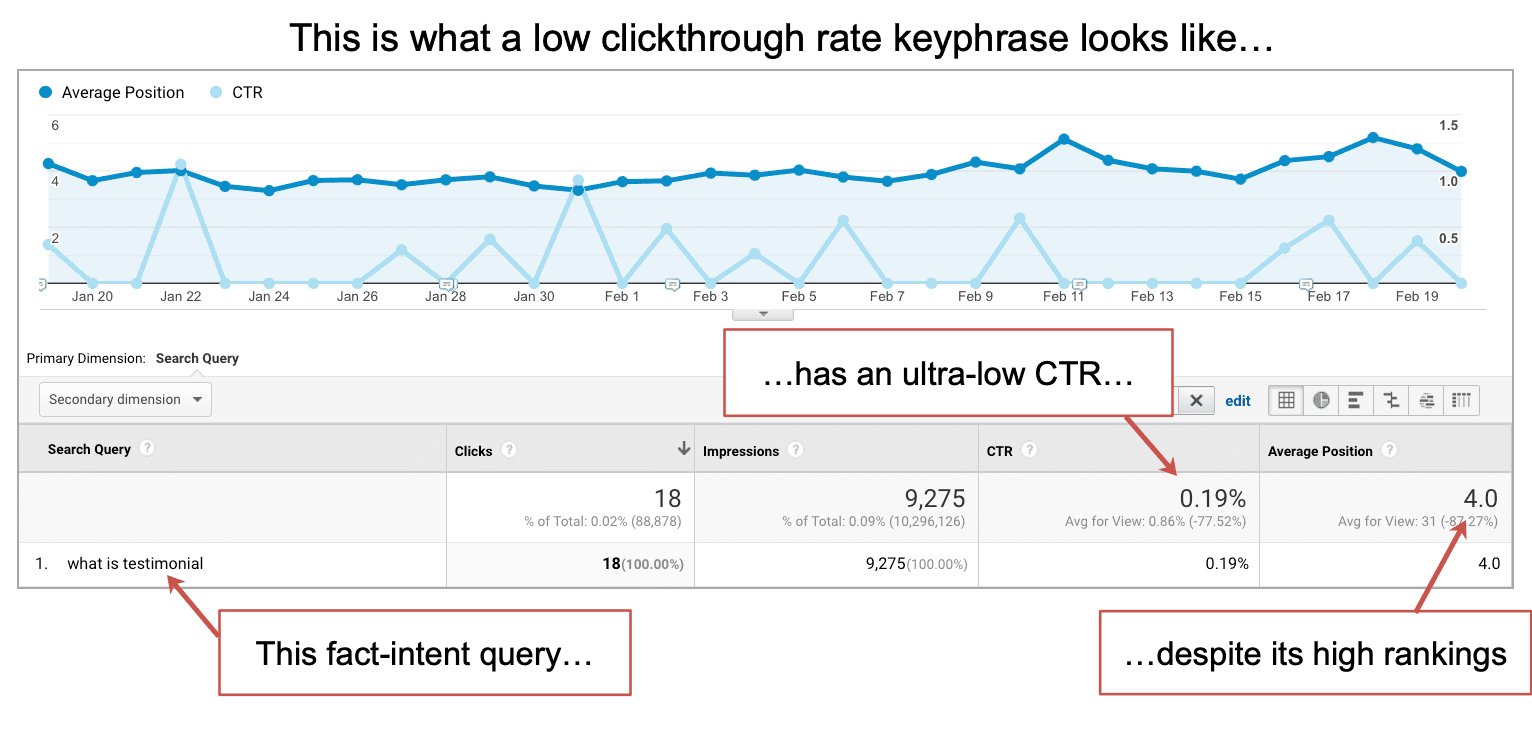
The reality is that nigh searches are zip-click searches.
Recall the early 2000's when publishing a glossary was a viable SEO strategy? This is why no ane does that anymore.
five. Don't bet the farm on SEO
Search is a powerful source of qualified traffic. It has the amazing potential to grow brand awareness and generate demand. And there are still millions of great keyword opportunities. You tin can target any of them with only a day of enquiry and writing.
But there is more to life than search.
In addition to search engine optimization, build upwards the other aspects of your marketing, digital and off-line.
- First, optimize your website for conversions.
You'll go more than value from every visitor forever after. Here's how. - Grow your email list.
The more y'all grow your list, the less you rely on digital giants for traffic. Hither'south how. - Write for other websites.
Publish content on any website that your audience visits. Here'southward how. - Utilise business relationship-based content marketing.
Even the tiniest brands with no Domain Authority can win. Here's how.
Annex: This article was originally published in March, 2019 and updated in March 2022. Here are the images showing side-past-side SERPs from that original post.
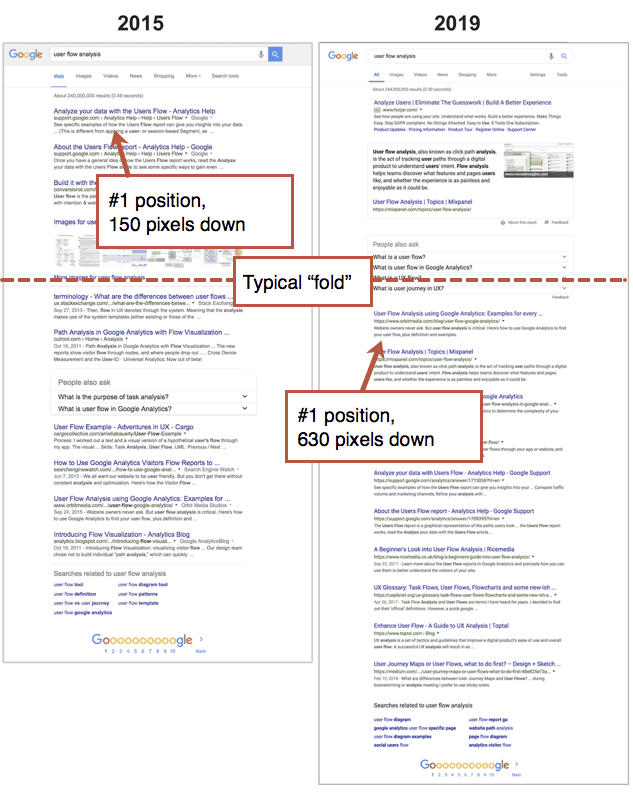
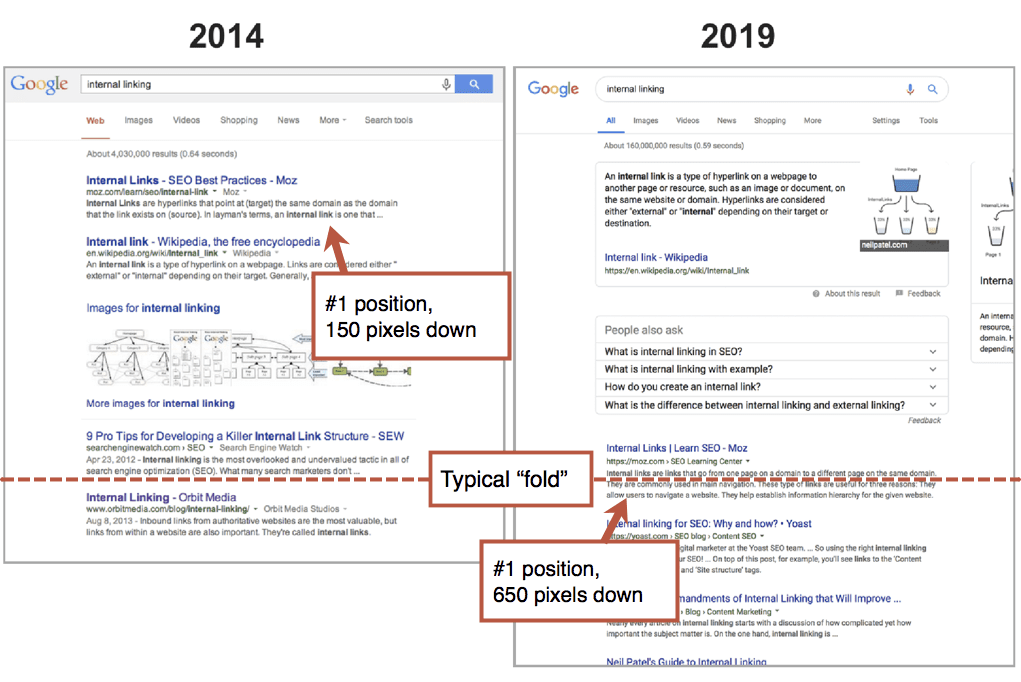
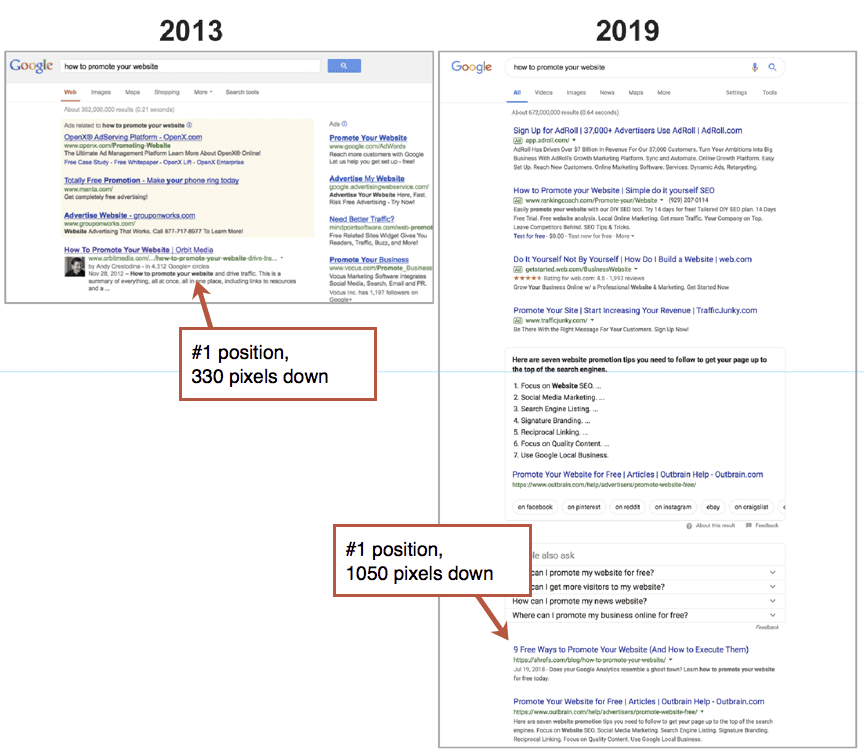
Source: https://www.orbitmedia.com/blog/biggest-trend-in-seo/
0 Response to "according to your reading about search and google, what are the two biggest trends in search"
Post a Comment